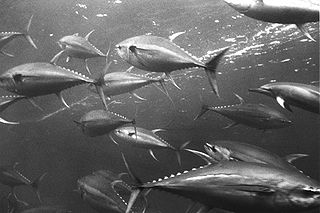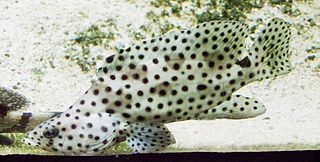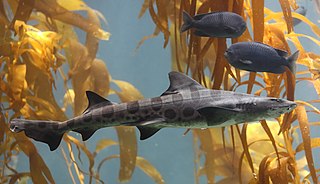
The mackerel, tuna, and bonito family, Scombridae, includes many of the most important and familiar food fishes. The family consists of 51 species in 15 genera and two subfamilies. All species are in the subfamily Scombrinae, except the butterfly kingfish, which is the sole member of subfamily Gasterochismatinae.

Serranidae is a large family of fishes belonging to the order Perciformes. The family contains about 450 species in 65 genera, including the sea basses and the groupers. Although many species are small, in some cases less than 10 cm (3.9 in), the giant grouper is one of the largest bony fishes in the world, growing to 2.7 m in length and 400 kg (880 lb) in weight. Representatives of this group live in tropical and subtropical seas worldwide.

Characidae, the characids or characins, is a family of freshwater subtropical and tropical fish belonging to the order Characiformes. The name "characins" is a historical one, but scientists today tend to prefer "characids" to reflect their status as a, by and large, monophyletic group. To arrive there, this family has undergone much systematic and taxonomic change. Among those fishes remaining in the Characidae currently are the tetras, comprising the very similar genera Hemigrammus and Hyphessobrycon, as well as a few related forms, such as the cave and neon tetras. Fish of this family are important as food in several regions, and also constitute a large percentage of captive freshwater aquarium fish species.

Tor is a genus of freshwater ray-finned fishes belonging to the family Cyprinidae, the family which includes the carps, barbs and related fishes. The fishes in this genus, and some related genera, are commonly known as mahseers. These fishes are found in Asia.

Combtooth blennies are blenniiformids; percomorph marine fish of the family Blenniidae, part of the order Blenniiformes. They are the largest family of blennies with around 401 known species in 58 genera. Combtooth blennies are found in tropical and subtropical waters in the Atlantic, Pacific and Indian Oceans; some species are also found in brackish and even freshwater environments.

Barbus is a genus of ray-finned fish in the family Cyprinidae. The type species of Barbus is the common barbel, first described as Cyprinus barbus and now named Barbus barbus. Barbus is the namesake genus of the subfamily Barbinae, but given their relationships, that taxon is better included in the Cyprininae at least for the largest part.

George Albert Boulenger was a Belgian-British zoologist who described and gave scientific names to over 2,000 new animal species, chiefly fish, reptiles, and amphibians. Boulenger was also an active botanist during the last 30 years of his life, especially in the study of roses.

Salmo is a genus of ray-finned fish from the subfamily Salmoninae of family Salmonidae, and is part of the tribe Salmonini along with the sister genera Salvelinus and Salvethymus. Almost all Salmo species are native only in the Old World, the only exception being the Atlantic salmon, which is also naturally found across the North Atlantic in eastern North America.

Lysianassidae is a family of marine amphipods, containing the following genera:

The Triakidae or houndsharks are a family of ground sharks, consisting of about 40 species in nine genera. In some classifications, the family is split into two subfamilies, with the genera Mustelus, Scylliogaleus and Triakis in the subfamily Triakinae, and the remainders in the subfamily Galeorhininae.

Gammaridae is a family of amphipods. In North America they are included among the folk taxonomic category of "scuds", and otherwise gammarids is usually used as a common name.

Palaemonidae is a family of shrimp in the order Decapoda. Many species are carnivores that eat small invertebrates, and can be found in any aquatic habitat except the deep sea. One significant genus is Macrobrachium, which contains commercially fished species. Others inhabit coral reefs, where they associate with certain invertebrates, such as sponges, cnidarians, mollusks, and echinoderms, as cleaner shrimps, parasites, or commensals. They generally feed on detritus, though some are carnivores and hunt tiny animals.
Acapoeta tanganicae, or the mbaraga, is a species of ray-finned fish in the family Cyprinidae. The genus Acopoeta is monotypic and is currently classified in the subfamily Torinae within the Cyprinidae.

Carasobarbus harterti, the stripeless himri, is a ray-finned fish species in the family Cyprinidae. It is found only in Morocco.

The giant Atlas barbel was a ray-finned fish species in the family Cyprinidae. It was the only species in the genus Atlantor but it is now thought to be extinct.

Carasobarbus, the himris, is a small genus of ray-finned fishes in the family Cyprinidae. Its species are found in rivers, streams, lakes and ponds in Western Asia and Northwest Africa. C. canis can reach 66 cm (26 in) in total length, but most other species are up to around half or one-quarter of that size.

Capoeta damascina, the Levantine scraper or Mesopotamian barb, is a species of cyprinid fish from the Near East region. It is reported from Iraq, Israel, Jordan, Lebanon, Syria, Iran and Turkey.
Labeobarbus gruveli is a species of ray-finned fish in the genus Labeobarbus which is known only from the Dubreka River in Guinea.

Jean Abel Gruvel was a French marine biologist known for his research of cirripedes.

The Serraninae is a subfamily of perciform ray-finned fishes in the family Serranidae. It is made up of ten genera and 87 species.


















